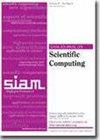振动系统的有限时域混合控制
IF 2.6
2区 数学
Q1 MATHEMATICS, APPLIED
引用次数: 0
摘要
SIAM 科学计算期刊》,第 46 卷第 3 期,第 B280-B305 页,2024 年 6 月。 摘要我们考虑有限时间范围内的振动系统控制问题。系统的性能指标是一个[math]混合[math]规范,它是标准[math]规范的一般化。我们提出了一种算法,用于在系统与参数相关、系统的输入或输出数量明显小于系统阶数的情况下高效计算该准则。我们的方法基于一个新颖的程序,它不基于求解李亚普诺夫方程,而是考虑到了系统的结构。我们使用自适应正交规则求解的积分来描述 [math] 准则。这使我们能够使用循环策略和并行化。新算法的高效性使得我们可以分析各种系统参数和不同有限时间范围对[math]混合[math]准则值的影响。我们通过一个带有一个阻尼器的[math]质量振荡器的数值示例来说明我们的方法。本文章由计算机程序翻译,如有差异,请以英文原文为准。
Finite Time Horizon Mixed Control of Vibrational Systems
SIAM Journal on Scientific Computing, Volume 46, Issue 3, Page B280-B305, June 2024.
Abstract. We consider a vibrational system control problem over a finite time horizon. The performance measure of the system is taken to be a [math]-mixed [math] norm which generalizes the standard [math] norm. We present an algorithm for efficient calculation of this norm in the case when the system is parameter dependent and the number of inputs or outputs of the system is significantly smaller than the order of the system. Our approach is based on a novel procedure which is not based on solving Lyapunov equations and which takes into account the structure of the system. We use a characterization of the [math] norm given in terms of integrals which we solve using adaptive quadrature rules. This enables us to use recycling strategies as well as parallelization. The efficiency of the new algorithm allows for an analysis of the influence of various system parameters and different finite time horizons on the value of the [math]-mixed [math] norm. We illustrate our approach by numerical examples concerning an [math]-mass oscillator with one damper.
Abstract. We consider a vibrational system control problem over a finite time horizon. The performance measure of the system is taken to be a [math]-mixed [math] norm which generalizes the standard [math] norm. We present an algorithm for efficient calculation of this norm in the case when the system is parameter dependent and the number of inputs or outputs of the system is significantly smaller than the order of the system. Our approach is based on a novel procedure which is not based on solving Lyapunov equations and which takes into account the structure of the system. We use a characterization of the [math] norm given in terms of integrals which we solve using adaptive quadrature rules. This enables us to use recycling strategies as well as parallelization. The efficiency of the new algorithm allows for an analysis of the influence of various system parameters and different finite time horizons on the value of the [math]-mixed [math] norm. We illustrate our approach by numerical examples concerning an [math]-mass oscillator with one damper.
求助全文
通过发布文献求助,成功后即可免费获取论文全文。
去求助
来源期刊
CiteScore
5.50
自引率
3.20%
发文量
209
审稿时长
1 months
期刊介绍:
The purpose of SIAM Journal on Scientific Computing (SISC) is to advance computational methods for solving scientific and engineering problems.
SISC papers are classified into three categories:
1. Methods and Algorithms for Scientific Computing: Papers in this category may include theoretical analysis, provided that the relevance to applications in science and engineering is demonstrated. They should contain meaningful computational results and theoretical results or strong heuristics supporting the performance of new algorithms.
2. Computational Methods in Science and Engineering: Papers in this section will typically describe novel methodologies for solving a specific problem in computational science or engineering. They should contain enough information about the application to orient other computational scientists but should omit details of interest mainly to the applications specialist.
3. Software and High-Performance Computing: Papers in this category should concern the novel design and development of computational methods and high-quality software, parallel algorithms, high-performance computing issues, new architectures, data analysis, or visualization. The primary focus should be on computational methods that have potentially large impact for an important class of scientific or engineering problems.

 求助内容:
求助内容: 应助结果提醒方式:
应助结果提醒方式:


